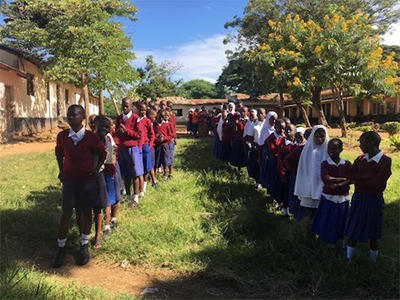Initiatives to control and eliminate parasitic disease are reaching targets earlier than projected
New data, analysed by a group of leading researchers, from nine national schistosomiasis control programmes, identified that the majority of initiatives across countries in sub-Saharan Africa and Yemen have reached the disease-control target by two treatment rounds or less, as opposed to the five to 10 years projected by current World Health Organisation (WHO) guidelines.

Schistosomiasis is a parasitic neglected tropical disease that is estimated to currently infect between 140-240 million people. Ninety percent of the disease burden is in sub-Saharan Africa, where the main species responsible for schistosomiasis in humans are water-borne parasites. These parasites belong to a group of blood flukes which are transmitted through faeces or urine, depending on the species, and cause symptoms including anemia, stunting, fever, genital lesions, and irreversible organ damage.
With a vision of “a world free of schistosomiasis”, WHO set ambitious goals to control this debilitating disease and eliminate it as a public health problem by 2020 and 2025, respectively. Currently, preventive chemotherapy with praziquantel - the only drug available - is the strategy recommended by WHO for the control of schistosomiasis.
As these milestones become imminent, and if programmes are to succeed, it was important to evaluate WHO’s programmatic guidelines. Therefore, the group – including leading experts from Imperial College, the Schistosomiasis Control Initiative (SCI Foundation), The Royal Veterinary College (RVC), RTI International, and the London Centre for Neglected Tropical Disease Research (LCNTDR) – working with national control programme leaders from each participating country, analysed and evaluated data covering multi-year, cross-sectional treatment programs in sub-Saharan Africa and Yemen to assess the progress.
The data were analysed according to schistocome species (intestinal or urogenital), the number of treatment rounds, overall prevalence, and prevalence of heavy-intensity infection. Disease control was defined as a prevalence of heavy-intensity infection of less than five per cent aggregated across sentinel sites, and the elimination target was defined as a prevalence of heavy-intensity infection of less than one per cent in all sentinel sites.
The results showed all but one country programme, Niger, reached the disease-control target by two treatment rounds or less. Programmes in areas with low endemicity levels at baseline were more likely to reach both the control and elimination targets than those in areas with moderate and high endemicity levels at baseline. Intracountry variation was also evident in the relationships between overall prevalence and heavy-intensity infection, a finding that highlights the challenges of using one metric to define control or elimination across all epidemiologic settings.

Dr Arminder Deol, Lead Author and currently Research Fellow at The London School of Hygiene & Tropical Medicine (LSHTM) said: “I’m excited to share the results of our paper which will enable us to improve our approach to achieving the global control and elimination targets for schistosomiasis, owing much to the hard work and dedication of staff at these control programmes. We move beyond theoretical outputs, and present empirical evidence through our partnership with the National Ministries of Health, to show that the goal of control may be reached sooner than proposed, which means that we can adjust our strategy to ensure we meet the elimination targets in time.” The overall data suggests the need to re-evaluate progress and treatment strategies in national schistosomiasis control programmes more frequently, with local epidemiologic data taken into consideration, in order to determine the treatment effect and appropriate resource allocations and move closer to achieving the global goals.
Professor Joanne P. Webster, Senior Author and Professor of Parasitic Diseases at the RVC said: “As we enter a new year, and indeed new decade, it is prime time to evaluate how much the schistosomiasis community has achieved towards reaching WHO’s goals; where, when and why the goals may not be met, and how frequently
re-evaluation should now be performed as we aim beyond with the help of the new Neglected Tropical Diseases roadmap. The inter- and intra-country variation was clearly evident, indicating the importance of both biological and operational factors in explaining and predicting infection persistence. Moving forward, these data show we may now need to move beyond the use of single metrics alone to define control, elimination or interruption of transmission global targets across all epidemiological settings.”
Dr Mike French, Co-Author and Implementation Director, USAID's Act to End NTDs | East Program, RTI International said: “Using extensive data from nine countries, this paper demonstrates the impact that national schistosomiasis control programmes are achieving. In particular, it highlights two important elements: firstly, that many programmes are making progress faster than expected – which is clearly good news in terms of benefit to public health. Secondly, that there is significant variation in results seen between countries and often within countries – suggesting that a more nuanced approach to control programmes is often needed. We hope that the results from this study can help international partners, such as WHO, to shape updated schistosomiasis guidelines.”
Dr Martin Walker, Co-author and Lecturer in Epidemiology at the RVC , said: “The beauty of the findings presented in this work is that they are based on a uniquely large quantity of hard epidemiological data. Ultimately, it is only these type of large-scale monitoring and evaluation data that will tell us how successful interventions against schistosomiasis are. It is all-important to acknowledge the work of SCI and their partner countries in facilitating the collection of these data and in making them public. I hope that this work will encourage other NTD communities to publish similarly illuminating data on progress towards control and elimination goals.”
Research reference
Deol, A., Fleming, F., Calvo-Urbano, B., Walker, M., Bucumi, V., Gnandou, I., Tukahebwa, E.M., Jemu, S., Mwingira, U.J., Alkohlani, A., Traore, M., SCI, Basáñez, M-G., French, M.D., & Webster, J.P. Schistosomiasis – assessing progress towards the 2020 and 2025 goals (2019) New England Journal of Medicine The full paper will be available from New England Journal of Medicine.
Notes to Editors
For more information please contact:
- Jasmin De Vivo (Jasmin.DeVivo@plmr.co.uk)
- Press Line: 0800 368 9520
About the RVC
- The Royal Veterinary College (RVC) is the UK's largest and longest established independent veterinary school and is a Member Institution of the University of London. It was the first in the world to hold full accreditation from AVMA, EAEVE, RCVS and AVBC.
- The RVC is ranked as the world’s number one veterinary school in the QS World University Rankings by subject, 2019.
- The RVC offers undergraduate and postgraduate programmes in veterinary medicine, veterinary nursing and biological sciences.
- In 2017, the RVC received a Gold award from the Teaching Excellence Framework (TEF) – the highest rating a university can receive.
- A research led institution with 79% of its research rated as internationally excellent or world class in the Research Excellence Framework 2014.
- The RVC provides animal owners and the veterinary profession with access to expert veterinary care and advice through its teaching hospitals and first opinion practices in London and Hertfordshire.
You may also be interested in:
-
New RVC study reveals how dragonfly wings can inform engineering and robotics
A new study led by the Royal Veterinary College (RVC) and Imperial College London has revealed how …

